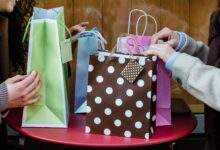Embrace the Secondhand: Shopping at Thrift Stores and Vintage Markets

Table of Contents
In recent years, there has been a significant transformation in consumer attitudes towards fashion in the United States. The fast fashion industry, once celebrated for its ability to quickly deliver the latest trends at affordable prices, is now under scrutiny for its detrimental environmental and ethical implications. As awareness of these issues grows, a shift towards sustainable fashion alternatives is becoming more pronounced. This movement reflects a broader change in consumer values, as more people recognize the importance of making responsible choices that benefit both society and the planet.
A. Shifting Consumer Values
Fast fashion, characterized by its rapid production cycles and low-cost garments, has come under fire for contributing to massive environmental degradation and poor labor practices. The fashion industry is one of the largest polluters globally, responsible for significant water consumption, chemical usage, and textile waste. Additionally, many fast fashion brands are linked to exploitative labor conditions in developing countries, where workers often endure long hours, low wages, and unsafe working environments.
As these issues gain visibility, US consumers are increasingly questioning the sustainability and ethics of their fashion choices. Reports and documentaries highlighting the dark side of fast fashion, coupled with the rise of social media platforms as tools for advocacy and education, have played a crucial role in driving this shift. Consumers are now looking for ways to reduce their ecological footprint and support ethical labor practices. This growing awareness has paved the way for a resurgence in the popularity of secondhand fashion, a sustainable and ethical alternative that offers a myriad of benefits.
B. The Magic of Secondhand
Embracing secondhand fashion is about more than just making a sustainable choice; it’s about discovering the magic that comes with it. One of the most alluring aspects of secondhand shopping is the opportunity to unearth unique and timeless pieces that aren’t available in mainstream stores. Thrift stores and vintage markets are treasure troves filled with one-of-a-kind items that add a distinctive flair to any wardrobe.
Shopping secondhand also directly contributes to reducing clothing waste. By purchasing pre-loved items, consumers help extend the life of garments, keeping them out of landfills and reducing the demand for new clothing production. This sustainable practice supports a circular economy, where resources are reused and recycled rather than discarded.
Another enticing benefit of secondhand fashion is the potential to find designer labels at a fraction of their original cost. High-end fashion becomes accessible to a broader audience, allowing more people to enjoy luxury items without the hefty price tag. Moreover, secondhand shopping fosters individuality and personal expression. Without the constraints of seasonal trends, shoppers can curate a wardrobe that truly reflects their unique style and personality.
C. A Nation of Secondhand Treasures
The United States boasts a vast and diverse landscape of thrift stores, consignment shops, and vintage markets. From large chains like Goodwill and The Salvation Army to small, independently-owned boutiques, there is no shortage of options for secondhand enthusiasts. Each region offers its own unique experience, with historical markets and local thrift shops providing a glimpse into the cultural fabric of their communities.
Cities like New York, Los Angeles, and Austin are renowned for their vibrant vintage scenes, where shoppers can find everything from retro fashion to antique collectibles. Additionally, online thrifting has surged in popularity, offering a convenient alternative to traditional brick-and-mortar stores. Platforms like ThredUp, Poshmark, and Depop make it easy for consumers to buy and sell secondhand clothing from the comfort of their homes, further democratizing access to sustainable fashion.
D. Embarking on Your Secondhand Journey
Secondhand shopping is not only environmentally friendly and ethically sound but also highly accessible and affordable. With countless options available, it’s easy for US consumers to incorporate secondhand fashion into their lives. Whether browsing a local thrift store, exploring a vintage market, or shopping online, the journey to a more sustainable wardrobe is within reach for everyone.
By redefining fashion through secondhand shopping, consumers can make a positive impact on the environment and society while enjoying the thrill of discovering unique, stylish pieces. This movement towards sustainable fashion is more than a trend; it’s a conscious choice that reflects a growing commitment to a better, more responsible way of living.
Navigating the Treasure Trove: A Guide to Thrift Stores and Vintage Markets
Embracing secondhand fashion not only helps the environment but also allows you to discover unique pieces that can enhance your wardrobe. Whether you’re new to secondhand shopping or looking to deepen your knowledge, understanding the landscape of thrift stores, vintage markets, and online platforms is essential. Here’s a comprehensive guide to navigating this treasure trove in the US.
A. Demystifying Thrift Stores
Understanding Thrift Stores
Thrift stores in the US typically operate on a donation model. These stores receive items from the public, which are then sold at discounted prices. The revenue generated often supports charitable organizations or community programs. For example, Goodwill and The Salvation Army use their proceeds to fund job training programs, shelters, and other social services.
Thrift stores have varied pricing structures, usually based on the type and condition of items. Prices are generally lower than retail, making them an excellent choice for budget-conscious shoppers. Many stores also have special discount days or color-coded tags that indicate further reductions.
Relevant Resources:
- Goodwill
- The Salvation Army
Benefits of Supporting Thrift Stores
Supporting thrift stores has numerous benefits:
- Charitable Support: Your purchases help fund important social programs and initiatives.
- Environmental Impact: Buying secondhand reduces waste and the demand for new clothing production, lowering your carbon footprint.
- Economic Savings: Thrift stores offer high-quality items at a fraction of the cost of new products.
Tips for Identifying Quality Items
Finding hidden gems in thrift stores requires a keen eye and a bit of patience. Here are some tips:
- Inspect for Quality: Check seams, zippers, and fabric for signs of wear or damage. Look for well-made items that can stand the test of time.
- Know Your Brands: Familiarize yourself with high-quality brands and their logos. This knowledge can help you spot valuable pieces quickly.
- Be Open-Minded: Go in with a flexible mindset. You might not find exactly what you’re looking for, but you can discover unexpected treasures.
- Frequent Visits: Thrift store inventory changes frequently. Regular visits increase your chances of finding great items.
Relevant Resources:
- Thrift Shopper
- How to Find Quality Items at Thrift Stores – Reader’s Digest
B. The Allure of Vintage Markets
Unique Atmosphere and Experience
Vintage markets offer a different shopping experience compared to thrift stores. These markets often feature curated collections of vintage clothing, accessories, and home goods, providing a nostalgic journey through past fashion eras. Each vendor brings a unique selection, creating a diverse shopping experience.
Popular vintage markets across the US include:
- Brooklyn Flea (New York): Known for its eclectic mix of vintage clothing, antiques, and handmade goods.
- Rose Bowl Flea Market (Pasadena, CA): One of the largest and most famous flea markets, featuring a wide array of vintage items.
- Austin City-Wide Garage Sale (Austin, TX): A large indoor market offering everything from vintage clothing to collectibles.
Meeting Vendors and Discovering Curated Collections
One of the highlights of vintage markets is the opportunity to meet vendors who are passionate about their collections. These vendors often have a deep knowledge of vintage fashion and can provide insights into the history and significance of their items. Engaging with them can enhance your shopping experience and help you learn more about vintage fashion.
Tips for Navigating Vintage Markets
- Arrive Early: Get there early to have the first pick of the best items.
- Bring Cash: While many vendors accept cards, having cash can simplify transactions and sometimes help with bargaining.
- Wear Comfortable Clothing: Vintage markets can involve a lot of walking and standing. Dress comfortably and be prepared to try on clothes.
- Bargain Tactfully: Bargaining is common in vintage markets, but do so respectfully. Start by asking if the vendor is open to negotiating the price.
Relevant Resources:
- Flea Market Insiders
- Tips for Navigating Vintage Markets – Country Living
C. Shopping Online Secondhand
Growing Popularity of Online Platforms
The rise of online thrift stores and marketplaces has made secondhand shopping more accessible than ever. Platforms like ThredUp, Poshmark, and Depop cater to the US market, offering a wide variety of secondhand clothing and accessories. These platforms provide the convenience of shopping from home and often feature search filters to help you find specific items quickly.
Relevant Resources:
- ThredUp
- Poshmark
- Depop
Benefits of Online Secondhand Shopping
- Convenience: Shop anytime, anywhere.
- Variety: Access a vast selection of items from multiple sellers.
- Ease of Comparison: Compare prices and conditions of similar items easily.
Tips for Safe and Reliable Online Shopping
- Check Seller Reviews: Look for sellers with positive reviews and ratings to ensure a reliable transaction.
- Read Descriptions Carefully: Pay close attention to item descriptions and photos. Look for details about the condition and any flaws.
- Understand Return Policies: Be aware of the platform’s return policies in case the item doesn’t meet your expectations.
- Use Secure Payment Methods: Always use secure payment methods provided by the platform to protect your financial information.
Relevant Resources:
- How to Safely Shop for Secondhand Clothes Online – The Good Trade
- The Best Online Thrift Stores – Reader’s Digest
D. Building Your Secondhand Arsenal
Essential Resources for US Consumers
To make the most of secondhand shopping, utilize various resources available to US consumers:
- Online Directories:
- The Thrift Shopper: A comprehensive directory of thrift stores across the US.
- Vintage Map: A user-friendly map highlighting vintage shops and markets nationwide.
- Apps Specializing in Secondhand Clothing:
- ThredUp: Offers a wide range of secondhand clothing with detailed listings and return policies.
- Poshmark: A popular platform for buying and selling gently used clothing and accessories.
- Depop: Known for its trendy and vintage clothing selections, appealing to a younger audience.
- Social Media Groups and Online Communities:
- Reddit’s r/ThriftStoreHauls: A community where users share their thrift store finds and tips.
- Facebook Marketplace: Local buying and selling, often featuring secondhand items.
- Instagram: Follow hashtags like #ThriftedFashion and #VintageFinds for inspiration and community interaction.
Cultivating Your Secondhand Style: Secrets of the Savvy Shopper
Secondhand shopping is a treasure hunt that combines sustainability with style. Embracing secondhand fashion not only helps the environment but also allows you to discover unique pieces that express your individuality. Here’s a guide to becoming a savvy secondhand shopper in the US, filled with tips and resources to enhance your shopping experience.
A. Preparation is Key
Research and Planning
Preparation is crucial for a successful secondhand shopping adventure. Start by researching local thrift stores, vintage shops, and online platforms. Websites like Thrift Shopper and Vintage Map offer directories of thrift stores and vintage shops across the US.
Creating a shopping list can help you stay focused. Assess your wardrobe to identify gaps and define your personal style. Are you looking for specific items like a vintage denim jacket or classic accessories? Having a clear idea of what you need will streamline your shopping experience.
Resources for Research
- The Thrift Shopper
- Vintage Map
- Thrift Store Hauls on Reddit
B. Decoding Quality and Sizing
Evaluating Garment Quality
When shopping secondhand, it’s essential to evaluate the quality of garments. Here are some tips:
- Fabric Check: High-quality fabrics like wool, silk, and cotton tend to last longer. Feel the fabric to ensure it’s not too worn out.
- Seams and Stitches: Inspect seams and stitching for signs of wear or loose threads. Well-constructed garments usually have tight, even stitches.
- Labels and Tags: Familiarize yourself with brand labels known for durability and quality. Brands like Levi’s, L.L. Bean, and Patagonia are often reliable choices.
Understanding Vintage Sizing
Vintage sizing can be tricky as it often differs from modern sizing. Here’s how to navigate it:
- Size Conversions: Use size conversion charts to understand how vintage sizes translate to modern sizes. Etsy’s Vintage Size Guide can be a helpful resource.
- Measurements Over Sizes: Focus on measurements rather than sizes. Bring a measuring tape and note your own measurements for a more accurate fit.
- Alterations: Don’t shy away from items that aren’t a perfect fit. Consider if simple alterations can make the piece work for you. Many dry cleaners and tailors offer affordable alteration services.
Inspecting for Damage
Before purchasing, thoroughly inspect items for any damage or wear:
- Check for Stains: Look for stains or discoloration, especially in hard-to-see areas like underarms and collars.
- Test Zippers and Buttons: Ensure zippers work smoothly and buttons are secure. Missing buttons can be easily replaced, but broken zippers might require more effort.
- Structural Integrity: Examine the overall structure of the garment, including linings and hems, to ensure they are intact.
Resources for Quality and Sizing
- Etsy’s Vintage Size Guide
- How to Assess Garment Quality
C. The Thrill of the Hunt
Embrace Discovery
One of the most exciting aspects of secondhand shopping is the element of discovery. Each trip can unveil unexpected treasures. Here’s how to make the most of it:
- Develop a Keen Eye: Practice spotting unique and vintage pieces by familiarizing yourself with different fashion eras and styles. Books like “Vintage Fashion Complete” by Nicky Albrechtsen can be great resources.
- Take Risks: Don’t be afraid to experiment with bold and unusual finds. Secondhand shopping allows you to try new styles without a significant financial commitment.
- Frequent Visits: Inventory in thrift stores changes frequently. Regular visits increase your chances of finding great pieces.
Resources for Vintage Fashion
- Vintage Fashion Complete by Nicky Albrechtsen
- Pinterest Vintage Fashion Boards
D. Beyond Clothing
Exploring Accessories and Jewelry
Secondhand shopping isn’t limited to clothing. Accessories, jewelry, and even home decor can be great finds. Here’s how to expand your search:
- Accessories: Look for scarves, belts, hats, and bags. Vintage accessories can add a unique touch to your outfits.
- Jewelry: Discover vintage jewelry pieces like brooches, rings, and necklaces. Ensure they are in good condition and consider their versatility.
- Home Decor: Vintage markets often feature home decor items. Look for unique pieces that reflect your style, from mid-century furniture to retro kitchenware.
Resources for Secondhand Accessories and Home Decor
E. Caring for Your Secondhand Treasures
Garment Care Tips
Proper care ensures your secondhand finds last longer. Here are some tips:
- Read Care Labels: Follow the care instructions on labels to avoid damaging delicate fabrics.
- Hand Washing: For vintage and delicate items, hand washing is often safer than machine washing.
- Proper Storage: Store items in a cool, dry place. Use padded hangers for delicate fabrics and avoid overcrowding in your closet.
DIY Cleaning and Repair
You can often refresh secondhand items with simple DIY methods:
- Stain Removal: Use natural stain removers like baking soda, vinegar, and lemon juice for gentle yet effective cleaning.
- Fabric Freshening: Air out garments to remove odors. For deeper refreshment, consider steaming.
- Basic Repairs: Learn basic sewing techniques to fix minor issues like loose buttons or small tears. Online tutorials can guide you through these processes.
Resources for Garment Care and Repair
- The Laundress
- Clothing Repair Tutorials on YouTube
Embrace Sustainability and Ethical Fashion
As consumers become more aware of the detrimental effects of fast fashion, many are turning to secondhand shopping as a more sustainable and ethical choice. This shift not only benefits the environment but also supports ethical labor practices and local communities. Here’s a closer look at why embracing secondhand fashion is a meaningful step toward a more sustainable future.
A. The Environmental Impact of Fashion
The Environmental Footprint of Fast Fashion
Fast fashion’s rapid production cycles and disposable mentality significantly contribute to environmental degradation. The fashion industry is one of the largest polluters globally, with significant water consumption, chemical usage, and greenhouse gas emissions. According to the United Nations Environment Programme, the fashion industry accounts for 10% of global carbon emissions and is the second-largest consumer of water.
Benefits of Secondhand Shopping
Secondhand shopping offers a sustainable alternative to fast fashion. By purchasing pre-owned clothing, consumers help reduce the demand for new garments, thus decreasing the environmental impact of production.
- Reduction in Clothing Waste: In the US, over 16 million tons of textile waste are generated annually, with only 15% being recycled. Secondhand shopping can significantly reduce this waste by giving clothes a second life.
- Lower Resource Consumption: Buying secondhand conserves the resources that would have been used to produce new clothing, including water, energy, and raw materials.
Data on Reducing Clothing Waste
Studies show that extending the life of clothing by just nine months can reduce its carbon, water, and waste footprint by 20-30%. Embracing the secondhand market can play a crucial role in achieving these reductions.
B. Ethical Labor Practices
Ethical Concerns in Fast Fashion
Fast fashion often relies on exploitative labor practices, including poor working conditions, low wages, and child labor. These practices are prevalent in many garment-producing countries, where labor rights are frequently ignored to keep production costs low.
Supporting Ethical and Sustainable Practices
Secondhand shopping reduces reliance on new garment production, thereby diminishing support for unethical labor practices. Additionally, many thrift stores and vintage shops in the US operate as charitable organizations, where profits support local communities and social initiatives.
- Economic Benefits: Supporting local thrift stores and charity shops helps stimulate local economies and provides funding for community projects and services.
- Promoting Ethical Brands: By reducing the demand for fast fashion, consumers can push the industry towards more ethical and sustainable production practices.
C. Becoming a Conscious Consumer
Informed Choices
Empowering consumers to make informed choices about their clothing purchases is key to fostering a sustainable fashion industry. Here are some ways to become a conscious consumer:
- Research Brands: Support brands committed to ethical labor and sustainable production. Websites like Good On You provide ratings and information on the ethical practices of various fashion brands.
- Embrace the Circular Fashion Economy: The circular fashion economy emphasizes keeping products in use for as long as possible. This includes buying secondhand, repairing, recycling, and reselling clothing.
Supporting Local and Sustainable Brands
Promoting and supporting brands that prioritize ethical labor practices and sustainability can lead to broader industry changes. Consumers can also participate in the circular economy by donating, recycling, and purchasing secondhand items.
- Local Thrift Stores: Use directories like Thrift Shopper to find local thrift stores that support charitable causes.
- Sustainable Fashion Initiatives: Engage with initiatives such as Fashion Revolution, which advocate for transparency and sustainability in the fashion industry.
It seems I’ve reached the limit of how much text I can process at once. Let’s break down the sections one by one to provide detailed information:
The Future of Secondhand: A Thriving Community
A. The Rise of the Secondhand Economy
Growing Popularity of Secondhand Shopping:
In the US, secondhand shopping has surged in popularity due to heightened environmental awareness and a shift towards sustainable consumption practices. Platforms like thredUP, Poshmark, and Depop have democratized access to secondhand fashion, appealing to eco-conscious consumers looking for unique and affordable clothing options. Social media platforms, particularly Instagram and TikTok, have played a significant role in promoting secondhand fashion through influencers and content creators who showcase their thrift finds, inspiring others to join the movement.
Environmental Impact:
Choosing secondhand clothing over fast fashion contributes to reducing the carbon footprint associated with new garment production. By extending the lifecycle of clothing, consumers help conserve resources and minimize waste, aligning with sustainable living principles.
B. Building a Sustainable Wardrobe
Curating a Timeless Wardrobe:
Secondhand shopping encourages the practice of slow fashion, which prioritizes quality, durability, and personal style over fleeting trends. Thrift stores and vintage shops offer a diverse array of clothing with historical and cultural value, allowing individuals to curate wardrobes that reflect their unique tastes and values.
Quality Over Quantity:
Secondhand garments often boast superior craftsmanship and materials compared to their fast fashion counterparts. By investing in well-made secondhand pieces, consumers not only acquire clothing with longer lifespans but also support sustainable practices by reducing demand for mass-produced items.
Upcycling and Personalization:
Embracing creativity through upcycling and customization enhances the appeal of secondhand fashion. DIY projects, such as altering clothing or repurposing accessories, transform pre-loved items into personalized treasures that express individuality and reduce reliance on new purchases.
C. The Power of Community
Fostering a Thriving Secondhand Community:
Participating in the secondhand fashion community fosters connections and shared values among like-minded individuals. Local vintage markets, swap meets, and online forums provide opportunities to discover curated collections, exchange styling tips, and engage in discussions about sustainable fashion practices.
Local Events and Markets:
Attending vintage markets and swap meets enables consumers to explore unique, pre-owned clothing while supporting local vendors and small businesses. These events celebrate the diversity of vintage fashion and promote a sense of community among thrift enthusiasts.
Learning and Mentorship:
Engaging with experienced thrifters and stylists offers valuable insights into navigating the world of secondhand fashion. Mentorship opportunities and online resources educate consumers about sustainable shopping practices, empowering them to make informed choices and advocate for ethical fashion.
D. Becoming an Advocate
Promoting Sustainable Practices:
As advocates for sustainable fashion, US consumers play a pivotal role in driving industry-wide change. By adopting mindful shopping habits and supporting brands committed to ethical production and transparency, individuals can influence positive outcomes in the fashion industry.
Reducing Fashion Waste:
Encouraging responsible clothing consumption, such as repairing, donating, or reselling garments, minimizes fashion waste and extends the lifecycle of clothing items. Participating in clothing swaps and donation drives promotes circular fashion economy principles, where resources are used more efficiently and sustainably.
Sustainability Initiatives:
Getting involved with organizations like Fashion Revolution USA empowers consumers to advocate for systemic changes in the fashion industry. Supporting initiatives that promote transparency, fair labor practices, and environmental stewardship helps create a more sustainable future for fashion.
Embracing Secondhand Fashion
A. Summary and Takeaways
In today’s fashion landscape, the allure of secondhand shopping in the US extends far beyond affordability and style. It represents a powerful movement towards sustainability and ethical consumption. By choosing secondhand fashion, consumers not only reduce their environmental footprint but also support a vibrant community of thrifters and vintage enthusiasts. The benefits are manifold: from discovering unique pieces with historical charm to contributing to a circular economy that values quality over quantity.
B. Taking the First Step
To embark on your secondhand adventure, start locally. Visit a nearby thrift store or attend a vintage market event in your area. These experiences offer more than just shopping—they provide opportunities to connect with sellers, learn about fashion history, and uncover hidden gems. Consider creating a personalized shopping list based on your wardrobe needs and personal style preferences. This focused approach ensures that each purchase aligns with your values and enhances your wardrobe in meaningful ways.
C. A Journey of Discovery
Embrace the excitement of the hunt and the joy of discovery that comes with secondhand shopping. Each piece tells a story and adds a unique flair to your wardrobe. By choosing secondhand, you not only express your individuality but also champion sustainable practices within the fashion industry. Let your secondhand journey be a reflection of your commitment to reducing clothing waste and making a positive impact on the environment.
Join the thriving community of secondhand fashion enthusiasts who are reshaping the way we think about style and sustainability in the US. Together, we can cultivate a future where fashion is both conscious and creative, where every purchase contributes to a more ethical and environmentally-friendly world. Start your secondhand journey today and discover the endless possibilities waiting to be unearthed.
Remember, every choice matters. By embracing secondhand fashion, you are not just dressing for today—you are shaping a better tomorrow for our planet and future generations.
Let’s celebrate style, sustainability, and the enduring beauty of secondhand fashion together. Join the movement and redefine fashion with purpose and passion.
Beyond the Basics: Deepen Your Secondhand Experience
A. The Art of Negotiation at Vintage Markets
Navigating vintage markets in the US involves more than just browsing—it’s about engaging in the art of negotiation. Approach vendors respectfully and be prepared to negotiate initial prices. Building rapport can often lead to better deals and a more enjoyable shopping experience. Remember, vintage markets are about connecting with sellers and appreciating the stories behind each piece.
B. Vintage Sizing Decoded: A US Guide
Understanding vintage clothing sizing can be daunting due to historical variations. In the US market, vintage sizes differ significantly from modern standards. Provide a comprehensive guide to decoding vintage sizes, detailing how measurements have evolved over time. Include vintage size charts and resources to help US consumers confidently navigate sizing challenges when shopping for unique pieces.
- Resources:
- Vintage Fashion Guild
- Rusty Zipper Vintage Clothing
- Adored Vintage
C. DIY Upcycling Projects for Secondhand Finds
Upcycling transforms secondhand clothing into personalized treasures. Introduce US consumers to DIY upcycling projects suitable for various skill levels. From simple alterations to more creative transformations, encourage creativity and sustainability. Empower individuals to add their personal touch to secondhand finds, turning them into unique fashion statements.
- Resources:
- The Refashionista
- Love to Sew Podcast
- Trash to Couture
D. Mastering the Art of Restoration
Preserving vintage clothing requires skillful restoration techniques. Discuss basic cleaning and restoration methods tailored to the US market. Offer tips for removing stains, repairing tears, and refreshing fabrics without compromising their integrity. Emphasize responsible restoration practices to maintain the authenticity and value of vintage garments.
- Resources:
- Textile Restoration Services
- The Laundress
- The Spruce
E. Building a Secondhand Community
Beyond online platforms, local communities in the US are thriving hubs for secondhand fashion enthusiasts. Highlight workshops, clothing swaps, and vintage fashion events across the country. Encourage US consumers to participate in these gatherings to connect with stylists, collectors, and like-minded individuals. These interactions foster creativity, inspire new ideas, and strengthen the commitment to sustainable fashion practices.
- Resources:
- Meetup (Search for local fashion and vintage events)
- Eventbrite (Discover local fashion and vintage markets)
- Local thrift store websites and social media pages
Secondhand Savvy: Your US Thrifting and Vintage FAQ
This FAQ tackles common questions you might have as a US consumer embarking on your secondhand shopping journey:
1. Where do I even begin with thrift stores?
No worries! Many online resources like Thrifted.com or the Goodwill Locator app (US) help you find thrift stores near you. Research stores in your area to discover their unique vibes and offerings.
2. What should I wear and bring to a vintage market? (US Focus)
Comfort is key! Wear clothes that allow for easy layering as you try on different vintage finds. Bring a tote bag for purchases and some cash in case not all vendors accept cards (common at US vintage markets).
3. How do I know if a piece is good quality in a thrift store?
Look for sturdy construction, well-sewn seams, and natural fibers like cotton or wool. Check for any rips, stains, or missing buttons. Consider the garment’s weight – quality materials often have a heavier feel.
4. Vintage sizing seems so confusing!
Don’t fret! Vintage clothing often runs smaller than modern sizes (US focus). Refer to vintage size charts online and compare measurements to clothes that already fit you well.
5. Is bargaining appropriate at vintage markets? (US Focus)
Absolutely! Bargaining is part of the vintage market experience (US). Start with a respectful offer and be prepared to negotiate. Remember, a positive and friendly approach goes a long way.
6. Can I find designer labels at thrift stores?
It’s definitely possible! Be patient and keep your eyes peeled for hidden gems. Some stores even have dedicated sections for designer finds.
7. What are some easy DIY projects for secondhand clothes?
The possibilities are endless! Hemming pants, adding patches or embellishments, or turning a vintage shirt into a cute crop top are great beginner projects.
8. How do I clean and care for vintage clothing?
Always check the care label and research cleaning methods based on the fabric type (common for vintage items). Gentle hand washing with mild detergent is often recommended.
9. Are there online communities for secondhand fashion enthusiasts? (US Focus)
Absolutely! Look for Facebook groups dedicated to vintage fashion in your area (US). Platforms like Poshmark and Depop also have vibrant online communities for secondhand lovers.
10. How can I get involved in the secondhand fashion movement?
Attend local vintage market events, host a clothing swap party with friends, or follow sustainable fashion influencers (US focus). By supporting secondhand and spreading the word, you make a difference!








